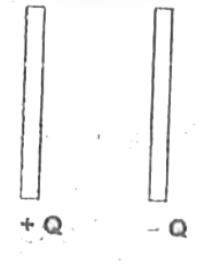The electrostatic force between the metal plate of an isolated parallel plate capacitro C having charge Q and area A, is
proportional to the square root of the distance betweenthe plates
linearly proportional to the distance between the plates
independent of the distance between the paltes
inversely proportional to the distance between the plates.
The correct Answer is:C
To solve the problem of finding the electrostatic force between the metal plates of an isolated parallel plate capacitor with charge Q and area A, we can follow these steps:
1. Understand the Setup:
We have a parallel plate capacitor with two plates. One plate has charge +Q and the other has charge −Q. The area of each plate is A.
2. Calculate the Electric Field:
The electric field E between the plates of a parallel plate capacitor can be calculated using the formula:
E=σϵ0
where σ is the surface charge density and ϵ0 is the permittivity of free space. The surface charge density σ is given by:
σ=QA
Therefore, the electric field E becomes:
E=QAϵ0
3. Calculate the Force on One Plate:
The force F on one plate due to the electric field created by the other plate can be calculated using the formula:
F=Q⋅E
Substituting the expression for E:
F=Q⋅(Q2Aϵ0)=Q22Aϵ0
Here, we use Q2Aϵ0 because the electric field due to one plate at the location of the other plate is half of the total electric field.
4. Conclusion:
The magnitude of the electrostatic force between the plates is:
F=Q22Aϵ0
5. Independence from Distance:
Notably, this expression shows that the force is independent of the distance d between the plates.
Final Answer:
The electrostatic force between the metal plates of an isolated parallel plate capacitor is given by:
F=Q22Aϵ0
We have a parallel plate capacitor with two plates. One plate has charge +Q and the other has charge −Q. The area of each plate is A.
The electric field E between the plates of a parallel plate capacitor can be calculated using the formula:
E=σϵ0
where σ is the surface charge density and ϵ0 is the permittivity of free space. The surface charge density σ is given by:
σ=QA
Therefore, the electric field E becomes:
E=QAϵ0
The force F on one plate due to the electric field created by the other plate can be calculated using the formula:
F=Q⋅E
Substituting the expression for E:
F=Q⋅(Q2Aϵ0)=Q22Aϵ0
Here, we use Q2Aϵ0 because the electric field due to one plate at the location of the other plate is half of the total electric field.
The magnitude of the electrostatic force between the plates is:
F=Q22Aϵ0
Notably, this expression shows that the force is independent of the distance d between the plates.
The electrostatic force between the metal plates of an isolated parallel plate capacitor is given by:
F=Q22Aϵ0
Topper's Solved these Questions
- BOOK - DC PANDEY ENGLISHCHAPTER - SOLVED PAPERS 2018EXERCISE - AIIMS22videos
SOLVED PAPERS 2018
- BOOK - DC PANDEY ENGLISHCHAPTER - SOLVED PAPERS 2018EXERCISE - Assertion and Reasons10videos
SOLVED PAPERS 2018
- BOOK - DC PANDEY ENGLISHCHAPTER - SOLVED PAPER 2017EXERCISE - Solved papers 2017(JIPMER)32videos
SOLVED PAPER 2017
- BOOK - DC PANDEY ENGLISHCHAPTER - WAVE OPTICSEXERCISE - For JEE Advanced E. Integer Type Questions13videos
WAVE OPTICS
Similar Questions
The electrostatic force between the metal plate of an isolated parallel plate capacitor C having charge Q and area A, is
View SolutionConsider a parallel plate capacitor having charge Q. Then,
 View Solution
View SolutionForce of attraction between the plates of a parallel plate capacitor is
View SolutionOn placing dielectric slab between the plates of an isolated charged condenser its
View SolutionThe separation between the plates of a charged parallel-plate capacitor is increased. The force between the plates
View SolutionThe force between the plates of a parallel plate capacitor of capacitance C and distance of separation of the plates d with a potential difference V between the plates, is.
View SolutionThe expression for the capacity of the capacitor formed by compound dielectric placed between the plates of a parallel plate capacitor as shown in figure, will be (area of plate =A)
 View Solution
View SolutionA parallel plate capacitor is charged. If the plates are pulled apart
View SolutionSTATEMENT-1 : If distance between plates of charged and isolated parallel plate capacitor increases then force between plates decreases.
and
STATEMENT-2 : Force between two point charges is inversely proportional to the square of distance of separation.View SolutionA charge of 20 microCoulomb is placed on the positive plate of on isolated parallel - plate capacitor of capacitance 10microFarad calculate the potential difference developed between the plates .
View Solution

